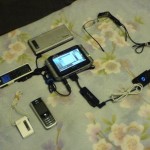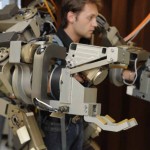Archive for Июль, 2009
A lower limb EMG-driven biomechanical model for applications in rehabilitation robotics
- Тип контента: Научная статья
- Номер документа: 1395
- Название документа: A lower limb EMG-driven biomechanical model for applications in rehabilitation robotics
- Номер (DOI, IBSN, Патент): Не заполнено
- Изобретатель/автор: Sartori, M., Reggiani, M., Pagello, E., Mezzato, C.
- Правопреемник/учебное заведение: Dept. of Inf. Eng., Univ. of Padova, Padova, Italy
- Дата публикации документа: 2009-07-28
- Страна опубликовавшая документ: Италия
- Язык документа: Английский
- Наименование изделия: Не заполнено
- Источник: http://ieeexplore.ieee.org/search/freesrchabstract.jsp?tp=&a
- Вложения: Да
- Аналитик: Дмитрий Соловьев
 Current changes in aging demographics poses new challenges: people require to keep their quality of life even after circumstances that threatened their movement and function. This increases the demand for new physical rehabilitation facilities that go beyond the traditional patient-therapist, one-to-one rehabilitation sessions. Two promising solutions rely on virtual reality and on the development of autonomous active orthoses, or exoskeletons. Whatever is the chosen approach, there is a requirement for a robust human-machine interface for the control, able to understand patient’s intention and to produce an immediate activation of the device. This paper presents a biomechanical model, a possible solution able to predict joint torque from the surface electromyography signals emitted by muscles during their activation. The main objective of the research is to investigate the benefits and efficacy of this model and to lay down the basis of our current research, whose main goal is to make possible a rehabilitation process either with active orthoses or virtual reality. Experiments involving all the steps of our model demonstrate the viability and effectiveness of our approach.
Current changes in aging demographics poses new challenges: people require to keep their quality of life even after circumstances that threatened their movement and function. This increases the demand for new physical rehabilitation facilities that go beyond the traditional patient-therapist, one-to-one rehabilitation sessions. Two promising solutions rely on virtual reality and on the development of autonomous active orthoses, or exoskeletons. Whatever is the chosen approach, there is a requirement for a robust human-machine interface for the control, able to understand patient’s intention and to produce an immediate activation of the device. This paper presents a biomechanical model, a possible solution able to predict joint torque from the surface electromyography signals emitted by muscles during their activation. The main objective of the research is to investigate the benefits and efficacy of this model and to lay down the basis of our current research, whose main goal is to make possible a rehabilitation process either with active orthoses or virtual reality. Experiments involving all the steps of our model demonstrate the viability and effectiveness of our approach.
Категория: Научные статьи | Нет комментариев »
Носимый компьютер — еще один этап «киборгизации».
- Тип контента: Новостная статья
- Номер документа: 4706
- Название документа: Носимый компьютер - еще один этап "киборгизации"
- Номер (DOI, IBSN, Патент): Не заполнено
- Изобретатель/автор: Не заполнено
- Правопреемник/учебное заведение: Не заполнено
- Дата публикации документа: 2009-07-28
- Страна опубликовавшая документ: Россия
- Язык документа: Русский
- Наименование изделия: Не заполнено
- Источник: http://www.3dnews.ru/news/nosimii_komputer_eshe_odin_etap_ki
- Вложения: Не заполнено
- Аналитик: Helix
 «Киборгизация» человека идет медленным, но верным путем. Регулярно совершенствующиеся искусственные конечности, имплантируемые под кожу чипы идентификации, бионические глаза, экзоскелеты, позволяющие поднять на порядок больший вес… Сейчас это всего лишь концепции или работающие прототипы с ограниченным функционалом.
«Киборгизация» человека идет медленным, но верным путем. Регулярно совершенствующиеся искусственные конечности, имплантируемые под кожу чипы идентификации, бионические глаза, экзоскелеты, позволяющие поднять на порядок больший вес… Сейчас это всего лишь концепции или работающие прототипы с ограниченным функционалом.
Категория: Амуниция | Нет комментариев »
Body Extender.Невероятный Халк существует и живет в Pontedera.
- Тип контента: Новостная статья
- Номер документа: 3206
- Название документа: Body Extender.Невероятный Халк существует и живет в Pontedera.
- Номер (DOI, IBSN, Патент): Не заполнено
- Изобретатель/автор: Не заполнено
- Правопреемник/учебное заведение: Не заполнено
- Дата публикации документа: 2009-07-24
- Страна опубликовавшая документ: Италия
- Язык документа: Русский
- Наименование изделия: Body Extender
- Источник: http://mmedia.kataweb.it/foto/6998774/1/l-incredibile-hulk-e
- Вложения: Не заполнено
- Аналитик: Не заполнено
 Невероятный Халк существует и находится в центре робототехники лаборатории Percro, Pontedera,школы Sant’Anna в Пизе. Это экзоскелет «Body Extender», усилитель и мультипликатор сила человека.Этот экзоскелет позволяет увеличить силу человека в десять раз. Проект, получивший название «Рубашка Халка», был создан по заказу Министерства обороны Италии.
Невероятный Халк существует и находится в центре робототехники лаборатории Percro, Pontedera,школы Sant’Anna в Пизе. Это экзоскелет «Body Extender», усилитель и мультипликатор сила человека.Этот экзоскелет позволяет увеличить силу человека в десять раз. Проект, получивший название «Рубашка Халка», был создан по заказу Министерства обороны Италии.
Категория: Body Extender | Нет комментариев »
Design and control of a lower limb exoskeleton for robot-assisted gait training
- Тип контента: Научная статья
- Номер документа: 3573
- Название документа: Design and control of a lower limb exoskeleton for robot-assisted gait training
- Номер (DOI, IBSN, Патент): 10.1080/11762320902784393
- Изобретатель/автор: Vanderborght, B., Van Ham, R., Van Damme, M., Lefeber, D., Beyl, P.
- Правопреемник/учебное заведение: Dept. of Mech. Eng., Vrije Univ. Brussel, Brussel
- Дата публикации документа: 2009-07-22
- Страна опубликовавшая документ: Бельгия
- Язык документа: Английский
- Наименование изделия: Не заполнено
- Источник: http://www.tandfonline.com/doi/abs/10.1080/11762320902784393
- Вложения: Нет
- Аналитик: Helix
 Robot-assisted rehabilitation of gait still faces many challenges, one of which is improving physical human-robot interaction. The use of pleated pneumatic artificial muscles to power a step rehabilitation robot has the potential to meet this challenge. This paper reports on the development of a gait rehabilitation exoskeleton with a knee joint powered by pleated pneumatic artificial muscles. It is intended as a platform for the evaluation of design and control concepts in view of improved physical human-robot interaction. The design was focused on the optimal dimensioning of the actuator configuration. Safety being the most important prerequisite, a proxy-based sliding mode controller (PSMC) was implemented as it combines accurate tracking during normal operation with a smooth, slow and safe recovery from large position errors. Treadmill walking experiments of a healthy subject wearing the powered exoskeleton show the potential of PSMC as a safe robot-in-charge control strategy for robot-assisted gait training.
Robot-assisted rehabilitation of gait still faces many challenges, one of which is improving physical human-robot interaction. The use of pleated pneumatic artificial muscles to power a step rehabilitation robot has the potential to meet this challenge. This paper reports on the development of a gait rehabilitation exoskeleton with a knee joint powered by pleated pneumatic artificial muscles. It is intended as a platform for the evaluation of design and control concepts in view of improved physical human-robot interaction. The design was focused on the optimal dimensioning of the actuator configuration. Safety being the most important prerequisite, a proxy-based sliding mode controller (PSMC) was implemented as it combines accurate tracking during normal operation with a smooth, slow and safe recovery from large position errors. Treadmill walking experiments of a healthy subject wearing the powered exoskeleton show the potential of PSMC as a safe robot-in-charge control strategy for robot-assisted gait training.
Категория: Ищем научные статьи | Нет комментариев »
Exoskeleton-based robotic platform applied in biomechanical modelling of the human upper limb
- Тип контента: Научная статья
- Номер документа: 3947
- Название документа: Exoskeleton-based robotic platform applied in biomechanical modelling of the human upper limb
- Номер (DOI, IBSN, Патент): 10.1080/11762320802697380
- Изобретатель/автор: Ruiz, A.F., Rocon, E., Forner-Cordero, A.
- Правопреемник/учебное заведение: Universidade de São Paulo
- Дата публикации документа: 2009-07-22
- Страна опубликовавшая документ: Бразилия
- Язык документа: Английский
- Наименование изделия: Не заполнено
- Источник: http://www.tandfonline.com/doi/abs/10.1080/11762320802697380
- Вложения: Нет
- Аналитик: Helix
 One of the approaches to study the human motor system, and specifically the motor strategies implied during postural tasks of the upper limbs, is to manipulate the mechanical conditions of each joint of the upper limbs independently. At the same time, it is essential to pick up biomechanical signals and bio-potentials generated while the human motor system adapts to the new condition. The aim of this paper is two-fold: first, to describe the design, development and validation of an experimental platform designed to modify or perturb the mechanics of human movement, and simultaneously acquire, process, display and quantify bioelectric and biomechanical signals; second, to characterise the dynamics of the elbow joint during postural control. A main goal of the study was to determine the feasibility of estimating human elbow joint dynamics using EMG-data during maintained posture. In particular, the experimental robotic platform provides data to correlate electromyographic (EMG) activity, kinetics and kinematics information from the upper limb motion. The platform aims consists of an upper limb powered exoskeleton, an EMG acquisition module, a control unit and a software system. Important concerns of the platform such as dependability and safety were addressed in the development. The platform was evaluated with 4 subjects to identify, using system identification methods, the human joint dynamics, i.e. visco-elasticity. Results obtained in simulations and experimental phase are introduced.
One of the approaches to study the human motor system, and specifically the motor strategies implied during postural tasks of the upper limbs, is to manipulate the mechanical conditions of each joint of the upper limbs independently. At the same time, it is essential to pick up biomechanical signals and bio-potentials generated while the human motor system adapts to the new condition. The aim of this paper is two-fold: first, to describe the design, development and validation of an experimental platform designed to modify or perturb the mechanics of human movement, and simultaneously acquire, process, display and quantify bioelectric and biomechanical signals; second, to characterise the dynamics of the elbow joint during postural control. A main goal of the study was to determine the feasibility of estimating human elbow joint dynamics using EMG-data during maintained posture. In particular, the experimental robotic platform provides data to correlate electromyographic (EMG) activity, kinetics and kinematics information from the upper limb motion. The platform aims consists of an upper limb powered exoskeleton, an EMG acquisition module, a control unit and a software system. Important concerns of the platform such as dependability and safety were addressed in the development. The platform was evaluated with 4 subjects to identify, using system identification methods, the human joint dynamics, i.e. visco-elasticity. Results obtained in simulations and experimental phase are introduced.
Категория: Ищем научные статьи | Нет комментариев »
Статистика
Категорий: 179
Статей всего: 2,003
По типу:
Видео: 36
Выдержка с форума: 1
Контактные данные: 12
Научная статья: 1388
Не заполнено: 5
Новостная статья: 317
Обзор технологии: 42
Патент: 219
Тех.подробности: 34
Тип: 1
Комментариев: 6,230
Изображений: 3,005
Подробней...
ТОР 10 аналитиков
-
Глаголева Елена - 591
Дмитрий Соловьев - 459
Helix - 218
Ридна Украина))) - 85
Наталья Черкасова - 81
max-orduan - 29
Елена Токай - 15
Роман Михайлов - 9
Мансур Жигануров - 4
Дуванова Татьяна - 3
Календарь
Авторизация
Ошибка в тексте?
Выдели её мышкой!
И нажми Ctrl+Enter